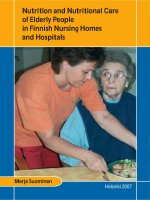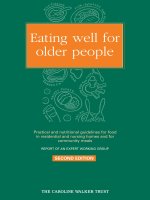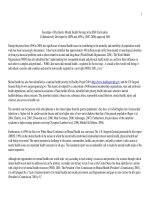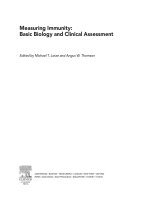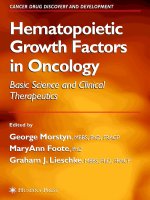Basic clinnical nursing skills
Bạn đang xem bản rút gọn của tài liệu. Xem và tải ngay bản đầy đủ của tài liệu tại đây (1.81 MB, 384 trang )
LECTURE NOTES
For Nursing Students
Basic Clinical Nursing Skills
Abraham Alano, B.Sc., M.P.H.
Hawassa University
In collaboration with the Ethiopia Public Health Training Initiative, The Carter Center,
the Ethiopia Ministry of Health, and the Ethiopia Ministry of Education
Novermber 2002
Funded under USAID Cooperative Agreement No. 663-A-00-00-0358-00.
Produced in collaboration with the Ethiopia Public Health Training Initiative, The Carter
Center, the Ethiopia Ministry of Health, and the Ethiopia Ministry of Education.
Important Guidelines for Printing and Photocopying
Limited permission is granted free of charge to print or photocopy all pages of this
publication for educational, not-for-profit use by health care workers, students or
faculty. All copies must retain all author credits and copyright notices included in the
original document. Under no circumstances is it permissible to sell or distribute on a
commercial basis, or to claim authorship of, copies of material reproduced from this
publication.
©2002 by Abraham Alano,
All rights reserved. Except as expressly provided above, no part of this publication may
be reproduced or transmitted in any form or by any means, electronic or mechanical,
including photocopying, recording, or by any information storage and retrieval system,
without written permission of the author or authors.
This material is intended for educational use only by practicing health care workers or
students and faculty in a health care field
PREFACE
Nursing is core part in health service delivery system in which health
promotion, disease prevention; curative and rehabilitative health
strategies are applied. The clinical nursing skills for the nurses are
of paramount important not only to provide comprehensive care but
also enhance clinical competence. The purpose of preparing this
lecture note is to equip nurses with basic clinical nursing skills, which
will enable them to dispatch their responsibility as well as to develop
uniformity among Ethiopian Professional Nurse Training Higher
Institutions.
The lecture note series is designed to have two parts: part-I is
composed of most basic clinical skills, where as part two will be
covering most advances clinical skills as well as fundamental
concepts related to the skills. It is well known that no nursing service
can be provided with out basic clinical nursing skills. For nurse to
provide health service at different settings; hospital, health center,
health post and at the community level including home based care
for chronically sick patients, the course is very essential. It is also
hoped that other primary and middle level health professional
training institution will utilize the lecture notes to rational exercise the
professional skills.
The lecture note is therefore organized in logical manner that
students can learn from simpler to the complex. It is divided in to
units and chapters. Important abbreviations and key terminologies
i
have been included in order to facilitate teaching learning processes.
On top of that learning objectives are clearly stated to indicate the
required outcomes. Glossary is prepared at the end to give
explanation for terminologies indicated as learning stimulants at
beginning of each chapter following the learning objectives. Trial is
made to give some scientific explanation for procedure and some
relevant study questions are prepared to each chapter to aid
students understand of the subject.
To enhance systematic
approach in conducting nursing care the nursing process is also
indicated for most procedures.
ii
ACKNOWLEDGEMENT
My deepest appreciation is to The Carter Center, EPHTI and
Professor Dennis Carlson, senior consultant of the Center for his
tireless efforts to materialize the issue of staff strengthening and
curriculum development. Lecture note preparation is one of the
activities that got due attention to strengthen the teaching learning
process in Ethiopia by Ethiopian staff. There fore, I congratulate
Professor Denis Carlson for the success you achieved with
dedicated Ethiopian partners.
I also extend many thanks to colleagues and staff of our School of
Nursing particularly Ato Andargachew Kassa and Ato Aweke Yilma
for their valuable comments and criticism, other wise the lecture note
would have not been shaped this way.
I would like to extend my thanks to Ato Asrat Demissie Academic
Vice President of Defence University College and Ato Daniel
Mengistu Head of School of Nursing in University of Gondar for their
critical review and valuable comments.
My sincere gratitude is also to the staff members of schools of
nursing, sister Universities, (Ato Birara Tadeg, GU, Ato Getachew
Worku, DUC, Sr. Netsanet Shiferaw, JU, Ato Tesfaye Abebe, HU)
for their tireless and meticulous revision of the material otherwise
difficulties would have faced to shape this way.
iii
Similarly, my felt thanks is to supportive staff of The Carter Center
EPHTI, Dr Hailu Yenenh, Ato Aklilu Mulugetta , W/rt Meseret
Tsegaw and all other staff for their devoted support through the
preparation of this lecture note.
Next, I thank all our College authorities for permission to work on
this lecture note besides the routine activities of the college.
Last but not least, my deepest gratitude is to W/rt Lemlem Adebabay
who has managed to write the document with in very urgency giving
up her rest time and comfort.
iv
TABLE OF CONTENTS
Content
Page
Preface .............................................................................................. i
Acknowledgement ........................................................................... iii
Table of Contents.............................................................................. v
List of Figures ................................................................................... xii
Abbreviation ...................................................................................... xiii
Unit One
Chapter 1 .......................................................................................... 1
Introduction ...................................................................................... 1
Definition of nursing .................................................................. 1
Historical background of nursing .............................................. 2
History of nursing in Ethiopia ................................................... 8
Nursing process and Critical thinking ...................................... 10
Unit Two Safety in Health Care facilities ...................................... 18
Chapter 2: infection control/ universal precaution ......................... 18
Nursing process application...................................................... 19
Normal body defense ............................................................... 22
Chain of infection ..................................................................... 24
Basic medical asepsis .............................................................. 26
v
Hand washing ........................................................................... 26
Standard precaution ................................................................. 29
Surgical asepsis........................................................................ 33
Isolation.................................................................................... 37
Chapter 3: Care of patient unit...................................................... 49
The patient unit ........................................................................ 50
Care of hospital and health care unit equipment ..................... 54
Unit Three Basic Client Care ........................................................ 58
Chapter 4: Admission, Transfer, and Discharge of client ............. 58
Admission ............................................................................... 59
Transfer................................................................................... 61
Discharge................................................................................ 62
Chapter 5: Vital Signs .................................................................. 66
Definition ................................................................................
Temperature .......................................................................... 69
Pulse ...................................................................................... 77
Respiration............................................................................. 82
Blood pressure....................................................................... 83
Chapter 6: Specimen collection ................................................... 90
General consideration for specimen collection...................... 91
Collecting stool specimen ...................................................... 92
Collecting urine specimen...................................................... 94
Collecting sputum .................................................................. 99
Collecting blood specimen....................................................... 101
Chapter 7: Bed making ................................................................. 109
Closed bed ............................................................................ 110
vi
Occupied bed......................................................................... 110
Post operative bed................................................................ 112
Chapter 8: Personal hygiene and skin care.................................. 120
Mouth care ............................................................................ 120
Bathing.................................................................................. 125
Bed bath.......................................................................... 128
Therapeutic bath............................................................ 131
Back care ............................................................................ 134
Giving and receiving bedpan and urinals ........................... 138
Perineal care....................................................................... 140
Hair cares............................................................................ 145
Pediculosis treatment ......................................................... 150
Chapter 9: Cold & heat application ............................................... 158
Care of a patient with fever................................................. 158
Heat application .................................................................. 159
Cold application .................................................................. 160
Tepid sponge ............................................................. 160
Local application of cold and heat ..................................... 161
Application of cold ........................................................... 161
Application of heat ............................................................. 163
Sitiz bath ............................................................................ 164
Chapter 10: Body mechanics and mobility ................................... 167
Body mechanics ............................................................... 168
Basic principles of body mechanics.................................. 168
Turning the patient to a side lying position ....................... 172
Joint mobility and range of motion.................................... 173
vii
Body positioning ............................................................. 177
Guideline for positioning the client............................ 177
Client positioning for examination & treatment......... 179
Crutch walking ................................................................. 183
Application of nursing process................................. 183
Teaching technique for crutch walking .................... 184
Teaching up stair and down stair walking with
crutch ...................................................................... 189
Helping the client into wheel chair ........................... 190
Unit Four ....................................................................................... 194
Chapter 11 Nutrition and metabolism .......................................... 194
Fluid and electrolyte balance........................................ 194
Acid base balance ........................................................ 200
Nutrition........................................................................ 208
Gastrostomy/jejunostomy feeding ......................... 211
Inserting a gastric tube .......................................... 211
Nasogastric feeding ................................................................. 217
Total parentral nutrition.......................................... 221
Unit Five
Chapter 12
Elimination of Gastro Intestinal and Urinary Tract
outputs............................................................229
Gastric lavage ...................................................230
Gastric aspiration ..............................................234
viii
Enema ..............................................................236
Cleansing enema ....................................237
Retention enema....................................241
Rectal washout...................................................242
Passing flatus tube ............................................243
Urinary catheterization .......................................244
Catheterization using straight catheter ...246
Inserting indwelling catheter.....................249
Unit Six
Chapter 13
Medication Administration ..........................................252
Definition of pharmacology...................................252
Drug metabolism ..................................253
Factors affecting drug metabolism.......255
Drug administration ..............................................256
Application of nursing process .........................257
Oral drug administration...................................259
Suppository ......................................................263
Subcutaneous injection .........................267
Intramuscular injection ..........................269
Intravenous injection ..............................273
ix
Intravenous therapy ...............................275
Blood transfusion .................................278
Cut down ..............................................283
Administration of vaginal medications..285
Administration of ophthalmic
medication .............................................287
Administration of otic medications .......290
Inhalation...............................................................292
Definition of inhalation..........................292
Oxygen administration ........................292
Giving oxygen by mask ........................292
Giving oxygen by nasal catheter.........294
Giving oxygen by tent..........................295
Steam inhalation .......................................297
Nelson’s inhalor........................................298
Unit Seven
Chapter 14 Wound cares ..........................................303
Definition ...................................................303
Wound healing process.............................304
Dressing a clean wound............................304
Dressing of septic wound ...........................307
Dressing with a drainage tube...................309
x
Wound irrigation ........................................312
Suturing .....................................................314
Removal of stitch.......................................316
Clip application and removal .....................318
Unit Eight
Chapter 15 Perioperative nursing cares ....................321
Preoperative care......................................321
Care the day before surgery ..........325
Care at the day of surgery..............326
Care just before surgery.................327
Intraoperative care ....................................332
Postoperative care ....................................332
Unit Nine
Chapter 16 Care of the dying & Post-mortem care . 338
Definition ...................................................338
Stages of dying..........................................340
Spirituality of dying ....................................339
Assisting the dying ....................................343
Care after death ........................................346
Glossary ......................................................................349
References ..................................................................363
xi
LIST OF FIGURES
Figure 1. Chain of infection .................................................................. 24
Figure 2. Site for radial pulse measurement ........................................ 80
Figure 3. Horizontal recumbent position .............................................. 179
Figure 4. Dorsal recumbent position .................................................... 179
Figure 5. Prone position ....................................................................... 180
Figure 6.Sim position............................................................................ 180
Figure 7. Fowler’s position ................................................................... 181
Figure 8. Knee-chest position............................................................... 181
Figure 9. Lithotomy position ................................................................. 182
Figure 10. Four –point-gait ................................................................... 185
Figure 11. Three-point-gait................................................................... 186
Figure 12. Two-point-gait ..................................................................... 187
Figure 13. Sites for IM injection............................................................ 271
Figure 14. Suture removal technique ................................................... 316
xii
ABBREVATIONS & SYMBOLS
ABG
Arterial Blood Gas
Ab
Antibody
ABCDE
Airway, breathing, circulation, disability, expose and
examine
A.C.
Before meal (ante cibum)
ACTH
Adreno cortico trophic hormone
AD.
As desired
ADL
Activities of daily living
AIDS
Acquire immeno deficiency syndrome
AI
Adequate intake
AM.
Morning
AMALG
Amalgam filling
AMA
Against medical advice
A and P
Auscultation and percussion
APC
Aspirin, Phenacetine & caffeine
AP
Apical pulse or antero-posterior
AQ
Aqueous
A-R
Apical radial pulse
AROM
Active range of motion; artificial rapture of
membrane
Ax
BID
Axillary
Twice a day (bis in die)
xiii
B.M
Bowel movement
B.M.R.
Basal metabolic rate
B.P
Blood pressure
BPM
Beat perminuli
B.R.P.
Bathroom privilege
BUN
Blood urea nitrogen
o
C
Centigrade
C.B. C
Complete blood count
CC
Cubic centimeter
C.N. S.
Central nervous system
Co2
Carbon dioxide
C.S. F.
Cerebro- spinal fluid
CXR
Chest X-ray
D and C
Dilatation and Curettage
D/NS
Dextrose in normal saline
DPT
Diphtheria, pertusis, tetanus
D/W
Dextrose in water
Dx
Diagnosis
EEG
Electro encephalogram
E.E.N.T.
Eye, ear, nose, throat
ECG
Electrocardiogram
o
Fahrenheit
F
F.B.S.
Fasting blood sugar
F.H.B.
Fetal heartbeat
G.I.
Gastro intestinal
G or Gm
Gram
xiv
gr.
Grain
gt.
Drop (gutte)
gtt.
Drops
G.U.
Genito urinary
GYN.
Gynecology
HCL
Hydrochloric acid
Hb
Hemoglobin
HS
At bed- time (hours of sleep)
H2o
Water
I.V.
Intravenous
I.V.P
Intravenous pyelogram
KI.
Potassium iodide
L. P
Lumbar puncture
NaCl
Sodium Chloride
NOCTE
At night
N.P.O.
Nothing by mouth (nothing by os)
O.P.D.
Out Patient Department
O.R.
Operating room
PM
After noon
PRN
As needed, when necessary
Pt.
Patient
Q.
Every
Q.D.
Every Day
Q.H.
Every Hour
Q.I.D.
Four times a day
Q.N.
Every night
xv
Q.O.D.
Every other day
R.B.C.
Red blood count or red blood cell
Rh.
Rhesus factor
Rx
Prescription, take
Sol.
Solution
SOS
If necessary
STAT
Immediately -at once
S.C
Subcutaneous
T. I.D
Three times a day
T.P.R.
Temperature, pulse, respiration
Tsp
Teaspoon, tablespoon
U.R.
Upper right
WBC
White blood cells
Wt.
Weight
U.R.Q.
Upper right quadrant
U.L.Q.
Upper lower quadrant
UTI
Urinary tract Infection
xvi
Basic Clinical Nursing Skills
UNIT ONE
CHAPTER 1
INTRODUCTION
Learning Objectives:
After completing this unit, the learners will be able to:
•
State the modern definition of nursing
•
Outline the historical background of nursing world wide and
in Ethiopia
•
Identify the contribution of significant individuals in nursing
•
Describe the nursing process
•
Describe critical thinking as an instrument for provision of
quality care
Nursing
Definition:
“It is the diagnosis and treatment of human responses to actual or
potential health problems” (ANA 1980).
It is assisting the individual, sick or well in the performance of those
activities contributing to health or its recovery (to peaceful death)
that he will perform unaided, if he had the necessary strength, will or
knowledge and to do this in such a way as to help him gain
independence as rapidly as possible (Virginia Henderson 1960).
1
Basic Clinical Nursing Skills
Nursing is the art and science that involves working with individual,
families, and communities to promote wellness of body, mind, and
spirit.
It is a dynamic, therapeutic and educational process that
serves to meet the health needs of the society, including its most
vulnerable members.
Historical Background of Nursing
Nursing has a history as long as that of human kind. Human beings
have always faced the challenge of fostering health and caring for
the ill and dependent. Those who were especially skilled in this area
stood out and, in some instances, passed their skills along to others.
Uprichard (1973) described the early history of nursing using three
images: the folk image, the religious image, and the renaissance
image.
The Folk Image of Nursing:
The Nurse as Mother
The early development of nursing was rarely documented, so we
must speculate about its character from what we know of early
civilizations. The nurse was generally a member of the family or, if
not, then a member of the community who demonstrated a special
skill in caring for others. Nursing in this perspective was seen largely
as a feminine role
an extension of mothering. Indeed, the word
nursing itself may have been derived from the same root as the
words nourish and nurture. This view of nursing was prevalent in the
earliest historical records and is still present in primitive cultures.
2
Basic Clinical Nursing Skills
The Religious Image of Nursing:
The Nurse as God’s Worker
In the Bible, a woman named Phoebe is identified as the first
deaconess, a word meaning servant or helper. Deaconess cared
for widows, orphans, and the sick. Olympias, a woman of
Constantinople, set up a hospital to care for the sick. In Rome,
Marcella established a monastery for those in need of care.
Fabiola, who was converted to Christianity by Marcella, established
hospitals for the sick poor. In the middle Ages, the traditional role of
the religious groups in caring for the ill was continued by various
orders of monks and nuns. When the crusade attempted to regain
Jerusalem from Muslim control, the Knights Hospitalers, and order
of religious workers who cared for the injured and fought to protect
them, marched with the armies. During this time, unfortunately, the
knowledge of hygiene and sanitation gained by Greek, Roman,
Egyptian, and other ancient civilizations was forgotten. There was no
growth or development in knowledge regarding care of the sick.
3
Basic Clinical Nursing Skills
Throughout the Middle Ages and into the Reformation, religious
orders ran almost all of the hospitals and provided most of the
nursing care in Europe. With the advent of the Reformation and the
presence of Protestant religious groups, the nature of these orders
changed. Women might join for a limited period of time, rather than
devoting the entire lifetime to service. They were again referred to as
deaconess, the term used in the early church. For example, a
church order of deaconesses was organized by Pastor Theodor
Fleidner in Kaiserswerth, Germany called the Sisters of Mercy of
the Church of England. Another order established St. John’s House,
an Anglican Hospital in London. The Protestant Nursing groups were
comprised totally of women, and only one nursing order made up of
men, the Brothers Hospitalers of St. John, remained in the
Catholic Church. The Muslim religion has a similar tradition of
service to others in the name of God. Rofiada al Islamiah, one of
the wives of Mohammand who cared for the sick and injured, is
considered the mother of nursing in the Mideastern Muslim countries
(Meleis, 1985).
The Renaissance Image of Nursing:
The Nurse as Servant
The Renaissance saw the decline of monastic orders and the rise in
individualism and materialism. There was a radical change from the
image of the selfless nurse that had developed in the early Christian
period and the Middle Ages. Care of the ill was delegated to
servants and those unable to find any other means of support. The
hospitals of this time were plagued by pestilence and filled with
4
Basic Clinical Nursing Skills
death; those who worked in them were seen as corrupt and
unsavory.
The Emergence of Modern Nursing
To some extent, the three early images of the nurse were held
simultaneously for hundreds of years. Then, in the 19th century, one
woman changed the course of nursing: Florence Nightingale.
Although born to wealth and a family well placed in Victorian English
Society, Florence Nightingale had a firm belief in Christian ideals
that made h1er disdainful of a life of luxury. She believed her true
calling was to minister to the sick. As an intelligent and welleducated woman, she recognized that optimum care of the sick
required education. She persevered against family and social
opposition and initiated personal study and research into sanitation
and health. She studied with Pastor Fleidner of 33, was to
reorganize the care for the sick at a hospital established for
“Gentlewomen in Distressed Circumstances.”
Nightingale’s success in her first post led Britain’s secretary of war to
recruit her for a far more arduous reorganization. Britain was then
engaged in a major war in the Crimea; reports were coming back
that more men died of wounds in the hospitals than on the
battlefield. Funds were raised and nurses recruited for Florence
Nightingale’s Crimean campaign. When she arrived at the front,
Nightingale found that conditions in the military hospitals were
abominable. The absence of sewers and laundry facilities, the lack
of supplies, the poor food, and the disorganized medical services
5
Basic Clinical Nursing Skills
contributed to a death rate of more than 50% among the wounded.
Nightingale insisted on retaining control of all of her supplies, funds,
and personnel. Her efforts and those of her staff reduced the death
rate among the wounded to less than 3%. She eventually completely
reformed the military’s approach to the health care of the British
soldier.
In 1860, she created a school of nursing, which was the model for
most nursing education in England. The school was organized
around three components: 1) a trained matron with undisputed
authority over all members of the staff, 2) a planned course of
theoretical and practical training, and 3) a home attached to the
hospital in which carefully selected students were placed in the care
of “sisters” responsible for their moral and spiritual training. (The
English term “sisters” used for secular nurses reflects nursing’s
religious history.) Nightingale established educational standards for
the students – she concerned herself not just with health care needs
but with human needs.
Her school prepared nurses for hospital care (where they were
called “ward sisters”) and for supervisory and teaching positions.
Nightingale also set up a program for preparing “district” nurses,
the public health/visiting nurses of England. She wrote that these
district nurses needed additional education because they would be
working more independently than the hospital staff members.
Nightingale’s strong statements about the role of nurses and their
need for lifelong education are still quoted widely today. Perhaps
6
Basic Clinical Nursing Skills
she, more than anyone else, can be credited with establishing
nursing as a profession.
In the early ages, much of the practice of medicine was integrated
with religious practices. Before the development of modern nursing,
women of nomadic tribes performed nursing duties, such as helping
the very young, the old, and the sick, care-dwelling mothers
practiced the nursing of their time.
As human needs expanded, nursing development broadened; its
interest and functions through the social climates created by
religious ideologies, economic development, industrial revolutions,
wars, crusades, and education. In this way modern nursing was
born.
The intellectual revolution of the 18th and 19th centuries led to a
scientific revolution. The dynamic change in economic and political
situations also influenced every corner of human development
including nursing. It was during the time of Florence Nightingale
(1820-1910) that modern nursing developed. She greatly modified
the tradition of nursing that existed before her era. She also
contributed to the definition of nursing “to put the patient in best
possible way for nature to act." Since her time modern nursing
development has rapidly occurred in many parts of the world.
7


